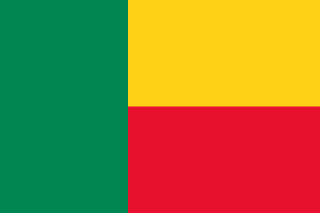
Benin, officially the Republic of Benin, and formerly Dahomey, is a country in West Africa. It is bordered by Togo to the west, Nigeria to the east, Burkina Faso to the north-west, and Niger to the north-east. The majority of its population lives on the southern coastline of the Bight of Benin, part of the Gulf of Guinea in the northernmost tropical portion of the Atlantic Ocean. The capital is Porto-Novo, and the seat of government is in Cotonou, the most populous city and economic capital. Benin covers an area of 114,763 square kilometres (44,310 sq mi) and its population in 2021 was estimated to be approximately 13 million. It is a small, tropical country. It is one of the least developed, with an economy significantly dependent on agriculture, and is an exporter of palm oil and cotton. Some employment and income arise from subsistence farming.

The mahi-mahi or common dolphinfish is a surface-dwelling ray-finned fish found in off-shore temperate, tropical, and subtropical waters worldwide. Also widely called dorado and dolphin, it is one of two members of the family Coryphaenidae, the other being the pompano dolphinfish. These fish are most commonly found in the waters around the Gulf of Mexico, Costa Rica, Hawaii and the Indian Ocean.
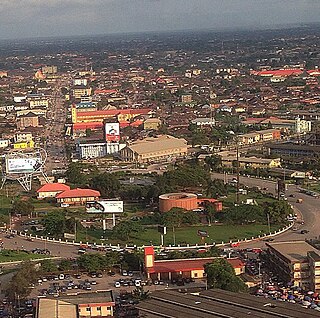
Benin City is the capital and largest city of Edo State, southern Nigeria. In central Kings square, the Benin city National Museum traces the Benin empire and has displays of terracotta sculpture. The Oba's palace is known for bronze plaques that once decorated with the walls, depicting historical events and Life at court. It is the fourth-largest city in Nigeria according to the 2006 census, after Lagos, Kano, and Ibadan. It is situated approximately 40 kilometres (25 mi) north of the Benin River and 320 kilometres (200 mi) by road east of Lagos. Benin City is the centre of Nigeria's rubber industry, and oil production is also a significant industry.
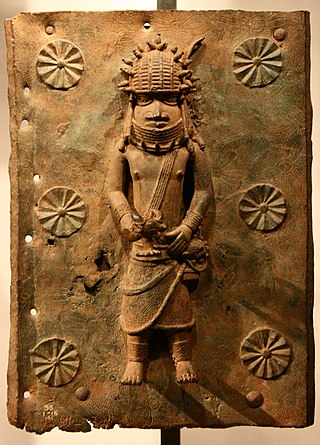
The Benin Bronzes are a group of several thousand metal plaques and sculptures that decorated the royal palace of the Kingdom of Benin, in what is now Edo State, Nigeria. Collectively, the objects form the best examples of Benin art and were created from the thirteenth century by artists of the Edo people. The plaques, which in the Edo language are called Ama, depict scenes or represent themes in the history of the kingdom. Apart from the plaques, other sculptures in brass or bronze include portrait heads, jewelry, and smaller pieces.
The Mahi are a people of Benin. They live north of Abomey, from the Togo border on the west to the Zou River on the east, and south to Cové between the Zou and Ouemé rivers, north of the Dassa hills.
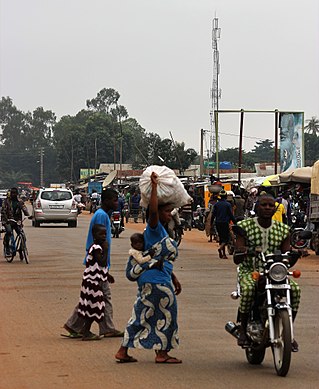
Collines is one of the twelve departments of Benin, located in the centre of the country. The department of Collines was created in 1999 when it was split off from Zou Department. In 2016, the city of Dassa-Zoumé became the department's capital.
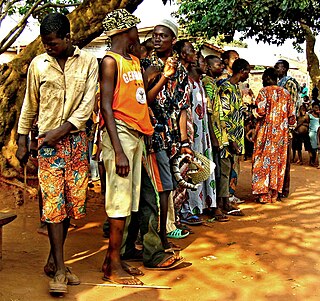
Cové is a city in the Zou Department of Benin. The commune covers an area of 525 square kilometres and as of 2012 had a population of 43,554 people.

La Bouche du Roi is an artwork by Romuald Hazoumé, an artist from the Republic of Bénin, West Africa, for the 200th anniversary of the abolition of slavery. It was bought by the British Museum, where it is on display in Room 35 from 22 March to 13 May 2007 before a 2-year tour to Hull, Liverpool, Bristol, Newcastle and London. The story of its acquisition was told in an episode of the documentary series The Museum.

The following outline is provided as an overview of and topical guide to Benin:
Za-Kpota or Zakpota is a town, arrondissement, and commune in the Zou Department of south-western Benin. It is located 153 kilometres north of Cotonou and 33 kilometres east of Abomey.

Zagnanado or Zangnanado is a town, arrondissement, and commune in the Zou Department of southern-central Benin. It is located 47 kilometres from Abomey and 165 kilometres north of Cotonou. The commune covers an area of 750 square kilometres and as of 2013 had a population of 132,401 people.

The Zou is a river of south-western Benin. It drains into the Ouémé River. The river banks are inhabited in parts by the Mahi people near the Togo border.
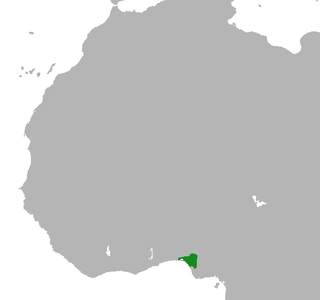
The Kingdom of Benin, also known as the Edo Kingdom or the Benin Empire, was a kingdom within what is now southern Nigeria. It has no historical relation to the modern republic of Benin, which was known as Dahomey from the 17th century until 1975. The Kingdom of Benin's capital was Edo, now known as Benin City in Edo State, Nigeria. The Benin Kingdom was "one of the oldest and most developed states in the coastal hinterland of West Africa". It grew out of the previous Edo Kingdom of Igodomigodo around the 11th century AD, and lasted until it was annexed by the British Empire in 1897.
Tervada is a village in Kankrej Taluka of Banaskantha district in Gujarat, India.
The Ohori are a subgroup of the Yoruba people of West Africa. The local domain of the Ohori is South-eastern Benin north of Pobè town expanding westwards to and west of the Ouémé River. Often, Ohoris, together with groups of Ifonyins, Aworis and Ketus are known collectively as 'Nagos" in Benin.
The Isha sometimes spelt Ica, and Itcha are a relatively small group of the Yoruba people, situated in the western parts of middle Benin, West Africa, especially in the town of Bantè and other surrounding communities in the Collines Department.

The Idaasha also spelt Idaaca, Idaaṣa and Idaaitsa are a group of the Yoruba people, situated in the central portions of the Collines Department of Benin, West Africa. They are based in and around the communities of Glazoué and Dassa both situated west of the Oueme River. Every year, the Idaasha organize a festival of arts and culture known as FACI to celebrate their culture and heritage, themed Àshà Ìbílẹ̀.
Dada Agonlinhossou Yèto Kandji is the 5th king of the Kingdom of Agonlin, a non-sovereign monarchy located in Benin. He has been monarch since 1993. His kingdom comprises the municipalities of Zagnanado, Covè and Ouinhi. His royal palace is located in Agonli-Houégbo, Zagnanado.










